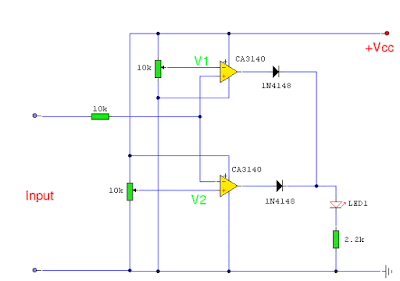This circuit will provide an indication whenever the input voltage differs from two defined limits, V1 and V2. The limits are adjustable and the circuit made to trigger from the adjustable "window".
Circuit Diagram:
Notes:
This circuit will provide an indication whenever the input voltage differs from two defined limits, V1 and V2. The supply voltage, Vcc must be higher than the highest input voltage by at least 2 volts. One application here is to monitor a 12V car battery. V1 could be set to 14V and V2 to 11V thus giving an indication of over charge or a weak battery.
Please Note. Only pins 7 and 4 (power supply), pin 6 (output) and pins 2 and 3 (inverting and non-inverting inputs) are used. All other pins are not connected. The pinout for the CA3140 is shown below.
The op-amps used here are MOSFET CA3140. They are used to advantage as they have very little output offset voltage and can switch down to near 0 volts. If any other op-amp is used such as LF351 or CA741 then it will be necessary to have an offset null control. This is just a 10k preset contacted between pins 1 and 5, the wiper connected to the negative supply rail or op-amp pin 4. With this circuit either op-amp will light the LED if the input voltage goes out of limits, the two 1N4148 diodes forming an "AND"-gate at the output. The input voltage to be monitored is fed via a series 10k resistor to inputs of both op-amps. If the input voltage is greater than the limit set by V1 then the CA3140 will swing its output to almost the full supply voltage and light the LED. Similarly, if the input voltage is less than the limit defined by V2 then this op-amp will swing towards Vcc and light the LED.
Circuit Diagram:
Notes:
This circuit will provide an indication whenever the input voltage differs from two defined limits, V1 and V2. The supply voltage, Vcc must be higher than the highest input voltage by at least 2 volts. One application here is to monitor a 12V car battery. V1 could be set to 14V and V2 to 11V thus giving an indication of over charge or a weak battery.
Please Note. Only pins 7 and 4 (power supply), pin 6 (output) and pins 2 and 3 (inverting and non-inverting inputs) are used. All other pins are not connected. The pinout for the CA3140 is shown below.
The op-amps used here are MOSFET CA3140. They are used to advantage as they have very little output offset voltage and can switch down to near 0 volts. If any other op-amp is used such as LF351 or CA741 then it will be necessary to have an offset null control. This is just a 10k preset contacted between pins 1 and 5, the wiper connected to the negative supply rail or op-amp pin 4. With this circuit either op-amp will light the LED if the input voltage goes out of limits, the two 1N4148 diodes forming an "AND"-gate at the output. The input voltage to be monitored is fed via a series 10k resistor to inputs of both op-amps. If the input voltage is greater than the limit set by V1 then the CA3140 will swing its output to almost the full supply voltage and light the LED. Similarly, if the input voltage is less than the limit defined by V2 then this op-amp will swing towards Vcc and light the LED.










0 comments:
Post a Comment